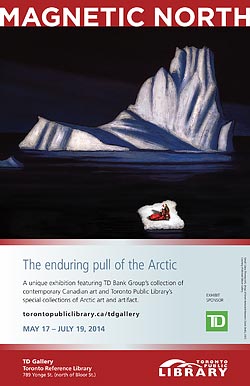Magnetic North

(image credit)
Diana Thorneycroft
Group of Seven Awkward Moments (Davis Strait), 2007
Digital Photograph
Collection of TD Bank Group

Samuel Smith
Icebergs
From: Log of Samuel Smith, Surgeon to the Hon. Hudson's Bay Co. Ship Prince Arthur from London to Moose Fort, Hudson's Bay, June 13 to August 24, 1857
Toronto Public Library
In this personal journal, Smith's observations on the voyage are interspersed with illustrations.
Transcription: 1st seen at 3 a.m; another from below the sun; one seen at a great distance off.
TD Gallery,
Toronto Reference Library
May 17 to July 19, 2014
Winding our way through the ice since 5am. A day never to be surpassed for beauty. Sea like glass...before us is seen a wall of ice.
Log of Samuel Smith, July 31st, 1857
It is so perfect and so beautiful, and it has nothing to do with us. We could only hurt it.
Sarah Anne Johnson, Canadian Art Magazine, Fall 2011
Bowhead whales have been around for as long as the Dorset people... I draw from my memory of the bowheads I’ve seen, and also from books.
Tim Pitsiulak, interview with Jessie Newton, 2011
Magnetic North is a journey of the mind to the Arctic through the eyes and imaginations of artists, explorers and academics who live there, have travelled there, or been inspired from afar to represent its elusive conditions. Most of us will only ever experience the North through story-telling in all of its forms: film, photography, carving, literature, music, prints and drawings. These mediated representations become the basis for our thoughts and understanding of this secluded place.
Inuit have been making artwork about their homeland and home lives for hundreds of years. Explorers began mapping, illustrating, and writing about their voyages as early as the 17th Century. Since then, intrepid artists from the world over have felt the northward pull of the landscape, the people and their culture, the wildlife, and the isolation. Magnetic North highlights all of these aspects and touches on dueling notions of tradition and change, isolation and connectedness, danger and beauty, celebration and loss.
Magnetic North is also the story of two very different collections coming together to expand the complex Arctic conversation. The Toronto Public Library’s Special Collections are rich in early maps, illustrated texts and journals, photographs, and ephemera while this selection from TD’s art collection features contemporary Canadian work including very recent Inuit drawings and carvings. Dramatic pairings between a Mercator Map of the North Pole from 1595 and Shuvinai Ashoona’s fantastical world map from 2011; from a tiny, delicate watercolor of icebergs rendered by a ship’s surgeon in 1857 to a nine-foot long drawing of migrating walrus from 2013 by Tim Pitsiulak; an English to Inuktitut dictionary from 1850 alongside Ovilu Tunnillie’s Thoughtful Woman, a carving of an Inuit woman contemplating the horrific news of 9/11 are just a few examples of how shifts in time, scale, and perspective propose that the North is many things and ever compelling.






 View exhibit poster.
View exhibit poster.